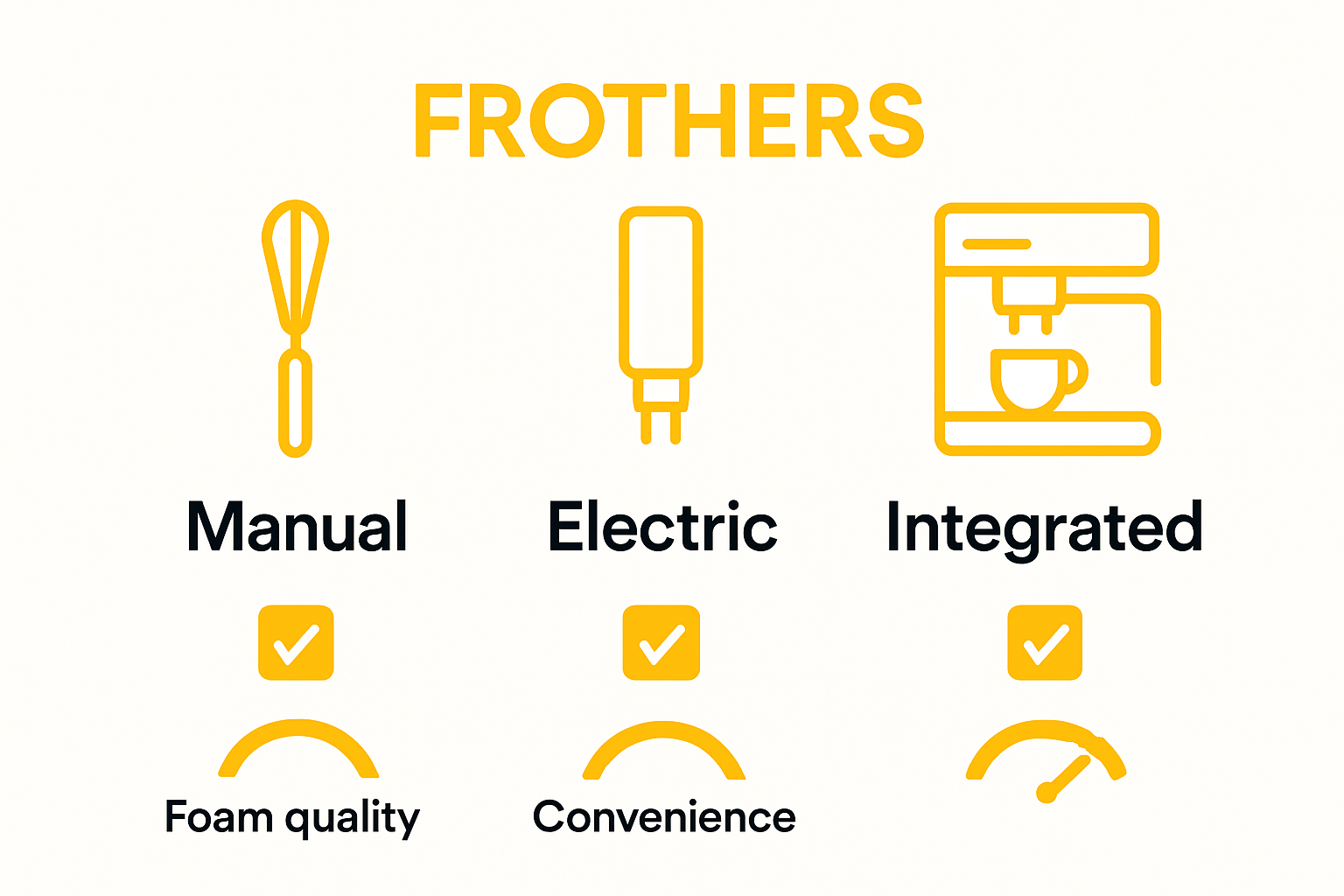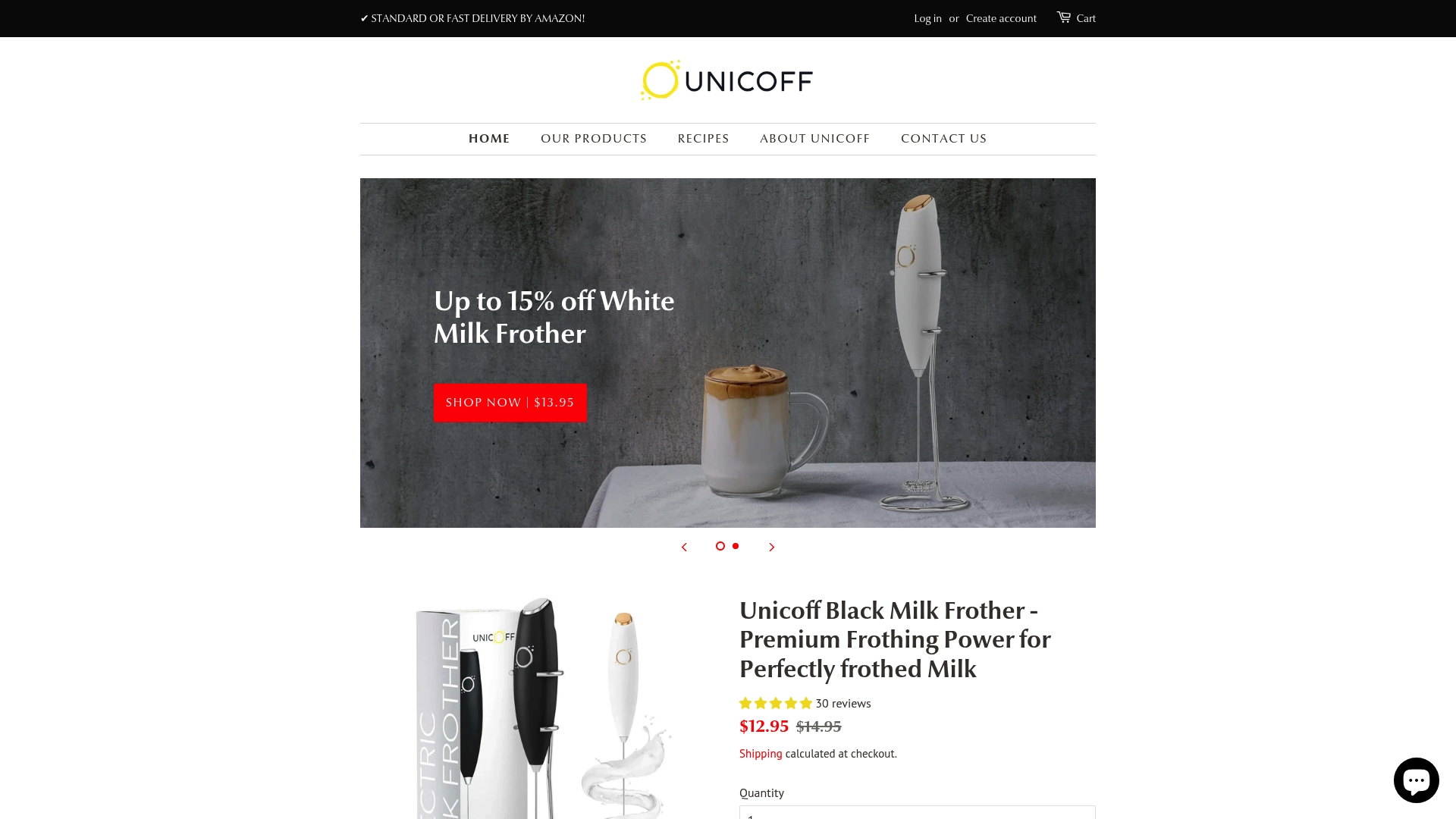Milk frothers have become the secret weapon for coffee lovers who crave café-style drinks at home and want that creamy, smooth texture every morning. Here is something most people miss: the right milk frothing technique can actually enhance your coffee’s antioxidant power according to the Journal of Dairy Science. So while many see frothing as just a way to create pretty foam, the real impact goes much deeper and changes not just the look but the entire flavor profile of your cup.
Table of Contents
- What Are Milk Frothers And Their Purpose?
- Why Milk Frothing Matters For Coffee Quality
- Exploring Different Types Of Milk Frothers
- How Milk Frothers Work: The Science Behind Frothing
- Practical Applications And Choosing The Right Frother
Quick Summary
| Takeaway | Explanation |
|---|---|
| Milk frothers enhance coffee beverages | They transform liquid milk into airy foam, creating cafe-style drinks at home. |
| Frothing improves flavor and texture | The process reduces bitterness and enhances smoothness, elevating coffee’s sensory experience. |
| Manual and electric frothers serve different needs | Choose between hands-on options or advanced electric models based on convenience and skill level. |
| Different milk types affect frothing quality | Experiment with various milks to achieve desired textures and flavors for your coffee drinks. |
| Selecting the right frother is crucial | Consider factors like power, temperature control, and ease of cleaning when choosing a frother. |
What Are Milk Frothers and Their Purpose?
Milk frothers are specialized kitchen tools designed to transform liquid milk into a light, airy foam ideal for enhancing coffee beverages. These ingenious devices introduce air into milk, creating a rich, creamy texture that elevates basic drinks into cafe-style experiences. Whether you enjoy cappuccinos, lattes, or macchiatos, a milk frother helps you achieve professional quality right in your own kitchen.
The Science Behind Milk Frothing
Frothing involves mechanically introducing air bubbles into milk, which changes its molecular structure and creates a stable foam. According to research from the Food Science and Technology Research Journal, this process depends on milk’s protein composition. When agitated, milk proteins like casein and whey unwind and form a protective layer around air bubbles, stabilizing the foam and creating that signature smooth, velvety texture coffee lovers crave.
Primary Functions and Benefits
Milk frothers serve multiple purposes beyond simple foam creation. They enable home baristas to:
- Customize drink textures from light and airy to dense and creamy
- Replicate professional cafe-style beverages at home
- Experiment with different milk types and foam consistencies
- Enhance visual and taste experience of coffee drinks
Whether you prefer a handheld milk frother or a more advanced electric model, these tools democratize gourmet coffee preparation, transforming ordinary morning routines into extraordinary culinary moments.
Why Milk Frothing Matters for Coffee Quality
Milk frothing is not merely a decorative technique but a crucial process that fundamentally transforms the sensory experience of coffee beverages. By introducing air and creating microfoam, frothing significantly enhances taste, texture, and overall drink quality. Professional baristas and home coffee enthusiasts understand that the right frothing technique can elevate an ordinary coffee into an extraordinary culinary creation.
Flavor Enhancement and Molecular Transformation
According to research published in the Journal of Dairy Science, adding frothed milk to coffee does more than create aesthetic appeal. The process actually enhances the beverage’s antioxidant properties through complex protein interactions. Milk proteins like casein and whey interact with coffee’s compounds, reducing bitterness and creating a smoother, more balanced flavor profile. These molecular interactions are critical in transforming a basic coffee into a sophisticated drink.
Sensory Experience and Textural Complexity
Frothing introduces multiple sensory dimensions to coffee. The microfoam created during frothing produces a velvety mouthfeel that significantly impacts taste perception. Different frothing techniques can create varying textures:
- Light and airy foam for delicate cappuccinos
- Dense, creamy microfoam for rich lattes
- Stable foam structures that maintain temperature and flavor integrity
- Consistent texture that enhances visual and gustatory pleasure
Explorers of coffee culture can discover professional milk frothing techniques with our black milk frother, designed to help you achieve barista-level results in your own kitchen.
Exploring Different Types of Milk Frothers
Milk frothers represent a fascinating array of kitchen tools designed to transform liquid milk into rich, creamy foam. Each type offers unique characteristics tailored to different coffee preparation styles, skill levels, and personal preferences. Understanding the nuanced differences between these devices helps coffee enthusiasts select the perfect tool for their specific needs.
To clarify the differences between manual and electronic milk frothers, the following table compares their features, benefits, and typical use cases side by side.
| Type of Milk Frother | Key Features | Typical Benefits | Ideal User/Scenario |
|---|---|---|---|
| Manual Frother | Hand-operated, no electricity needed, basic design | Affordable, portable, easy to clean | Hands-on users, travel, smaller kitchens |
| Mechanical Pump/Plunger Frother | Uses plunger mechanism, simple construction | Good foam control, durable | Barista-style customization, budget seekers |
| Handheld Electric Whisk | Battery powered, compact, easy to use | Quick frothing, minimal cleanup | Everyday convenience, small spaces |
| Standalone Electric Frother | Plug-in, automatic, temperature options | Consistent results, auto shut-off | Home users needing precision |
| Integrated Espresso Machine | Built-in steam wand/frother | Cafe-grade frothing, high performance | Serious enthusiasts, latte art fans |
| Countertop Pro Frother | Large, professional capacity, advanced options | Multiple settings, high volume use | Entertaining, large households |
Manual and Mechanical Milk Frothers
Manual milk frothers require direct human interaction and come in several distinct designs. These include handheld whisks, plunger style frothers, and pump mechanisms that rely on physical movement to introduce air into milk. According to research from Pennsylvania State University, innovative design approaches have significantly improved the efficiency and performance of manual frothing tools.

Electronic and Automated Milk Frothing Systems
Electronic milk frothers represent the pinnacle of convenience and precision in milk preparation. These sophisticated devices are categorized into multiple subtypes:
- Integrated espresso machine frothers
- Standalone electric milk frothers
- Handheld battery powered whisks
- Countertop professional grade frothers
Each electronic variant offers consistent temperature control and precise foam texture, making them ideal for home baristas seeking professional results.
 Explore our comprehensive milk frother collection to find the perfect device that matches your coffee preparation style and kitchen aesthetic.
Explore our comprehensive milk frother collection to find the perfect device that matches your coffee preparation style and kitchen aesthetic.
How Milk Frothers Work: The Science Behind Frothing
Milk frothing is a complex molecular process that transforms ordinary milk into a rich, creamy foam through precise physical manipulation. This scientific transformation involves intricate interactions between milk proteins, air, and mechanical energy, creating a sophisticated culinary experience that goes far beyond simple mixing.
Protein Dynamics and Foam Formation
Milk proteins play a critical role in creating stable foam structures. According to Penn State researchers, the key to successful frothing lies in understanding protein denaturation. When milk is agitated, proteins like casein and whey unwind from their original structure, creating a protective membrane around air bubbles. This protein network stabilizes the foam, preventing rapid bubble collapse and maintaining the desired texture.
Mechanical Energy and Foam Complexity
Different milk frothers generate foam through varied mechanical approaches, each producing unique textural results:
- Steam-based systems using high pressure
- Mechanical whisking that introduces rapid air incorporation
- Rotational devices creating centrifugal foam expansion
- Vibration techniques that break milk surface tension
Each method manipulates milk’s molecular structure differently, influencing foam density, stability, and mouthfeel. Explore our precision milk foam maker to experience professional-grade frothing technology that harnesses these scientific principles.
Practical Applications and Choosing the Right Frother
Selecting the ideal milk frother requires understanding your specific coffee preparation needs, kitchen setup, and personal preferences. Different frothers excel in various scenarios, making the selection process both nuanced and crucial for achieving your desired coffee experience.
Matching Frothers to Coffee Styles
Each coffee style demands a unique foam texture and temperature, requiring careful frother selection. Espresso-based drinks like cappuccinos and lattes require precise microfoam with consistent temperature control. According to Consumer Reports, the most versatile frothers can handle multiple milk types including dairy and plant-based alternatives, ensuring flexibility for diverse dietary preferences.
Key Selection Considerations
When choosing a milk frother, coffee enthusiasts should evaluate several critical factors:
- Power and speed of foam generation
- Temperature control capabilities
- Compatibility with different milk varieties
- Ease of cleaning and maintenance
- Budget and long-term durability
- Noise levels during operation
For those seeking authentic insights from real users, explore customer experiences and reviews to understand how different milk frothers perform in everyday kitchen environments. By carefully considering these factors, you can select a frother that transforms your home coffee preparation into a professional-grade experience.
To help guide selection, this table summarizes critical factors to consider when choosing a milk frother based on information from the article.
| Consideration | Description | Why It Matters |
|---|---|---|
| Power & Speed | How quickly and efficiently froth is created | Impacts time and convenience |
| Temperature Control | Ability to set/maintain desired milk temperature | Essential for microfoam and specific coffee styles |
| Milk Compatibility | Works with dairy and various plant-based milks | Ensures versatility for different diets |
| Ease of Cleaning | Simplicity of maintenance and washing | Affects long-term use and hygiene |
| Durability & Budget | Build quality, longevity, and price point | Influences value and replacement frequency |
| Noise Level | Operational loudness | Important in shared or quiet environments |
Turn Coffee Know-How Into Café-Style Perfection at Home
After learning how distinct milk frothers can upgrade your coffee experience, you may be wondering how to turn that knowledge into delicious results in your own kitchen. If you crave smooth microfoam, customized textures, and a professional finish for every cup, the right frother makes all the difference. Many coffee lovers struggle to find a trusted product that creates consistent, café-quality foam with ease. Unicoff offers a carefully curated selection of frothers, ensuring you get both simplicity and professional features, whether you love airy cappuccino foam or creamy latte microfoam. Explore customer favorites and find the best milk frother to match your style on our Best Milk Frother for Your Home | Shop Now page.

Why wait for coffee shop lines or unpredictable results at home? With Unicoff, you get access to reliable kitchen gadgets and verified customer reviews, so you can choose with confidence. Discover your ideal frother for every coffee type at Unicoff.com and shop exclusive deals today. Bring café-quality coffee to your kitchen now.
Frequently Asked Questions
What are the different types of milk frothers available?
There are mainly two types of milk frothers: manual and electronic. Manual frothers include handheld whisks and pump-style frothers, while electronic frothers include integrated espresso machine frothers and standalone electric frothers.
How do I choose the right milk frother for my coffee style?
Choosing the right milk frother depends on the specific coffee style you prefer. For example, espresso-based drinks like cappuccinos and lattes require precise microfoam, so an electronic frother with temperature control may be ideal.
Can I use different types of milk with a frother?
Yes, most milk frothers are versatile enough to work with various types of milk, including dairy and plant-based alternatives. Ensure that your frother is compatible with the type of milk you wish to use.
What makes froth from a milk frother stable?
The stability of froth is primarily due to the milk’s protein composition. When the milk is agitated, proteins like casein and whey form a protective layer around air bubbles, preventing them from collapsing and creating a stable foam.
